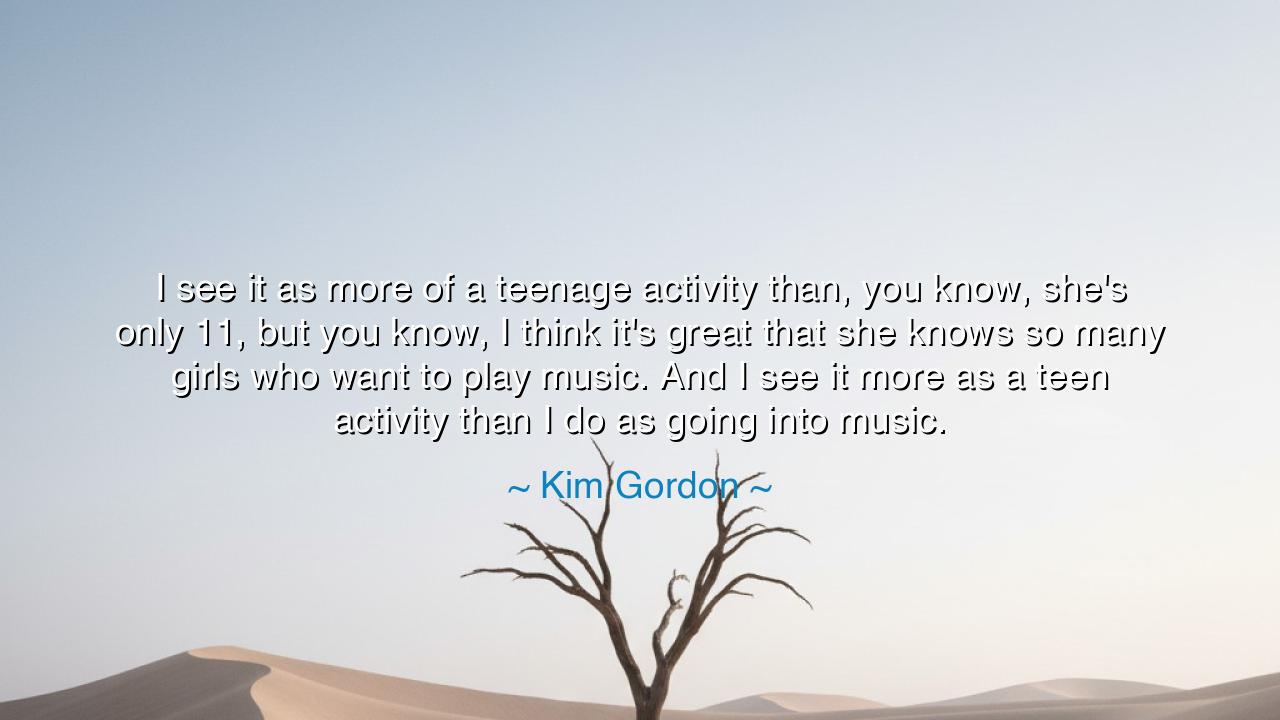
I see it as more of a teenage activity than, you know, she's
I see it as more of a teenage activity than, you know, she's only 11, but you know, I think it's great that she knows so many girls who want to play music. And I see it more as a teen activity than I do as going into music.






Kim Gordon once mused with thoughtful observation: "I see it as more of a teenage activity than, you know, she's only 11, but you know, I think it's great that she knows so many girls who want to play music. And I see it more as a teen activity than I do as going into music." Within this reflection lies the recognition of youthful experimentation, the way children and teens first approach the arts not with the weight of career, but with the joy of exploration, belonging, and play. Gordon acknowledges that music at such a young age is less about profession and more about identity, friendship, and expression.
The origin of her words is tied to Gordon’s own life as a founding member of Sonic Youth, a band that challenged convention and carved out its own sound. As both a musician and a mother, she observed the way music weaves into the lives of the young. To her, the sight of girls forming bands or playing music together was a victory, not because it meant a destined career in the arts, but because it offered them a place to gather, to create, and to claim space in a world that often discourages young girls from lifting their voices.
Her perspective resonates with history. Consider the circles of young poets in ancient Greece, who gathered not for fame but for the joy of reciting verse together. Or the story of the Brontë sisters, who as children created imaginary worlds and filled them with stories long before they ever became published authors. In both cases, what began as an “activity” of youth would later blossom into something enduring, but its roots lay in play, community, and the innocence of creation. Gordon recognizes this truth: that art begins in joy before it becomes vocation.
Her words also speak to the social power of music. When young girls come together to play instruments or sing, they are not simply making sounds; they are building bonds, discovering confidence, and creating their own culture. Music at this stage is as much about identity and solidarity as it is about melody. It is in these teenage years that many discover who they are, and music becomes both mirror and torch—reflecting their emotions and lighting their path.
At the same time, Gordon warns against pressing children too soon into the mold of career. At age 11, music should not be a burden or an obligation but a space of freedom and discovery. To impose the weight of “going into music” at such a tender age risks suffocating the joy that makes it powerful in the first place. In her wisdom, she calls us to honor the stages of growth: let childhood be playful, let the teen years experiment, and let vocation, if it comes, arise naturally.
For us, the lesson is profound: let art begin as play before it becomes purpose. Encourage the young to explore, to create, to make noise without fear of perfection. Do not measure them too quickly by standards of professionalism or success, for the flame of creativity is fragile and must be nurtured gently. Let them find joy first, and in time, if their passion endures, it may become something greater.
Therefore, children of tomorrow, take Kim Gordon’s wisdom to heart. When you are young, pursue art not as a burden but as delight. When you guide the young, give them space to play, to fail, to learn, and to grow. For in the songs sung in bedrooms, in the chords strummed in garages, in the laughter of friends making music together, lies the beginning of futures we cannot yet see. Let art be a garden of joy, not a prison of expectation. From joy springs true creation.






AAdministratorAdministrator
Welcome, honored guests. Please leave a comment, we will respond soon